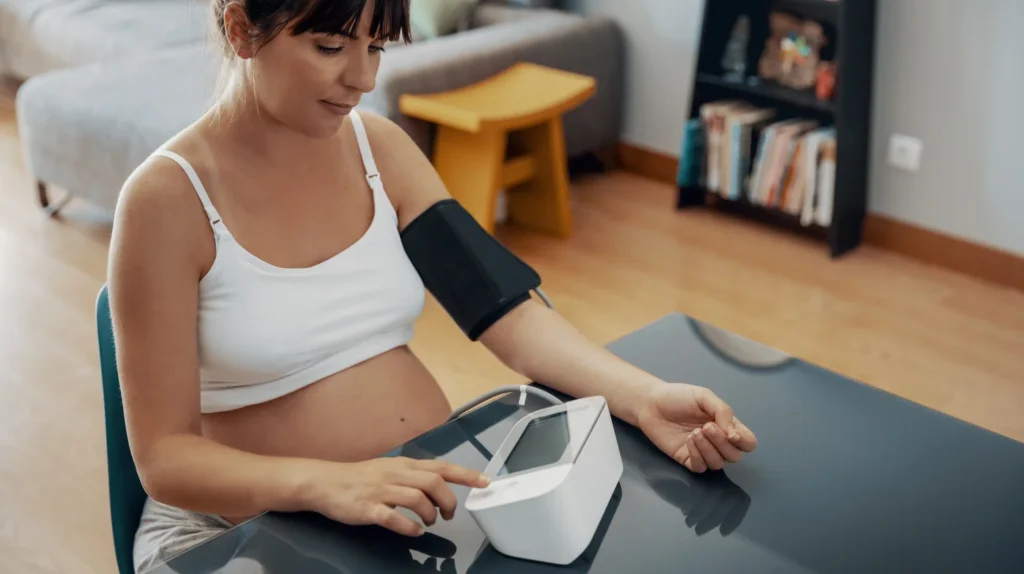
Did you know that approximately 2% to 8% of pregnancies are affected by a potentially dangerous health condition called preeclampsia? The pregnancy journey, while filled with joyful anticipation, can also bring various health concerns. One of them, preeclampsia, poses significant risks if not diagnosed and managed promptly.
This article aims to shed light on this condition, discussing its risk factors, signs, potential complications, and management strategies. Stay with us as we delve into the subject because being informed is your best defense against this pregnancy-related complication.
What is Preeclampsia?
Preeclampsia is a condition that primarily occurs during pregnancy, typically after the 20th week, and is characterized by high blood pressure and the presence of protein in the urine. It’s crucial to note that preeclampsia is not just about high blood pressure during pregnancy; the combination of hypertension and proteinuria sets it apart.
Preeclampsia can range from a mild to a severe condition, the latter being capable of causing serious, even fatal, complications for both the mother and baby if not managed promptly. Some women may develop preeclampsia early in their pregnancy, while others might notice symptoms close to their due date or even after delivery in rare instances, known as postpartum preeclampsia.
Understanding preeclampsia is essential for every pregnant woman, as it can occur without any previous history of high blood pressure or other risk factors. While certain factors may increase your likelihood of developing the condition, preeclampsia can strike without warning, making regular prenatal care and vigilance for its signs and symptoms critical.
Risk Factors for Preeclampsia
Preeclampsia can happen to any woman, regardless of her overall health or history. However, certain factors can increase the likelihood of developing this condition. Understanding these risk factors can help in early detection and effective management.
- First-time Pregnancy: Women experiencing their first pregnancy are more likely to develop preeclampsia than women who have previously given birth. This is particularly true for teen pregnancies and pregnancies in women over 40.
- Family History: If your mother or sister had preeclampsia, you might be more likely to develop the condition.
- Pre-existing Conditions: Women with pre-existing conditions like diabetes, high blood pressure, kidney disease, lupus, or obesity are at an increased risk.
- Multiple Pregnancies: Women carrying twins, triplets, or more are more likely to develop preeclampsia than women carrying one baby.
- Interval between Pregnancies: Women who have pregnancies over ten years apart also have an increased risk.
- History of Preeclampsia: If you had preeclampsia in a previous pregnancy, your risk of developing it in future pregnancies is higher.
Understanding your individual risk factors can aid in proactive monitoring and prevention strategies. Remember, having a risk factor doesn’t mean you will develop preeclampsia, but you should be extra vigilant and maintain regular communication with your doctor.
Signs and Symptoms of Preeclampsia

Preeclampsia can sometimes develop without obvious symptoms, making regular prenatal checkups essential. However, there are several signs and symptoms that may suggest the onset of preeclampsia.
- High Blood Pressure: A significant rise in blood pressure is one of the most common signs of preeclampsia.
- Proteinuria: Excess protein in the urine, usually detected during a routine prenatal urine test.
- Swelling: While some swelling is normal during pregnancy, sudden swelling of the hands, face, or legs can be a sign of preeclampsia.
- Abdominal Pain: Upper abdominal pain, usually under the ribs on the right side, can be a warning sign.
- Nausea or Vomiting: A sudden return of morning sickness in the second half of your pregnancy could be a symptom.
- Vision Changes: Temporary loss of vision, blurred vision, or light sensitivity can be symptoms of severe preeclampsia.
- Rapid Weight Gain: Gaining more than 2 pounds (0.9 kg) a week can be a sign.
Remember, these symptoms may not necessarily mean you have preeclampsia, but if you experience any of them, you must contact your doctor immediately. Early detection and prompt treatment can help manage this condition effectively and prevent serious complications.
Complications of Preeclampsia
Preeclampsia poses a significant risk to both the mother and the baby, especially if it is not detected and treated promptly. Here are some of the potential complications:
- For the Mother:
- Eclampsia: This is a severe form of preeclampsia that can lead to seizures and is a serious threat to both the mother and the baby.
- Organ Damage: Persistent high blood pressure can cause damage to vital organs like the kidneys, liver, and brain.
- HELLP Syndrome: This is a rare but severe liver and blood clotting disorder that can develop before any signs of preeclampsia are evident.
- Cardiovascular Disease: Preeclampsia increases the risk of future cardiovascular disease, including heart disease and high blood pressure.
- For the Baby:
- Preterm Birth: Babies born before 37 weeks can have many health problems, including difficulties breathing and feeding, developmental issues, and a weakened immune system.
- Low Birth Weight: Because preeclampsia can affect the placenta’s ability to provide enough nutrients, babies may be smaller than average at birth.
- Intrauterine Growth Restriction: This refers to poor growth of a baby while in the mother’s womb during pregnancy.
Preeclampsia can lead to life-threatening complications if left untreated, making early detection and management vital.
Causes of Preeclampsia
The exact cause of preeclampsia remains unknown. However, research suggests that several factors may contribute to this condition. Primarily, it’s thought to relate to the placenta and blood flow.
- Placental Problems: Preeclampsia often begins with problems in the development of the placenta. If the placenta’s blood vessels don’t develop or function properly, it can lead to poor blood flow, resulting in less oxygen and nutrients for the baby, which can trigger preeclampsia.
- Genetic Factors: Certain genetic variations may increase the risk of preeclampsia.
- Blood Vessel Damage: Existing damage to blood vessels, possibly due to factors like high blood pressure, diabetes, or high cholesterol, could contribute to the development of preeclampsia.
- Immune System Response: An abnormal immune response to the pregnancy might play a role.
Despite these possible causes, more research is necessary to understand fully why some women develop preeclampsia, and others do not. Understanding the causes will lead to better future prediction, prevention, and treatment strategies.
Testing and Diagnosing Preeclampsia

Diagnosing preeclampsia involves careful monitoring and various tests. The first step is usually regular checks of blood pressure during prenatal visits.
- Blood Pressure Checks: If you have a blood pressure reading of 140/90 millimeters of mercury (mm Hg) or higher on two occasions at least four hours apart, you may be diagnosed with high blood pressure during pregnancy. You may be diagnosed with severe preeclampsia if these readings reach 160/110 mm Hg.
- Urine Tests: During each prenatal visit, you may have your urine tested for protein — a condition called proteinuria. In preeclampsia, high levels of protein are often found in the urine due to the kidneys not filtering it properly.
In addition to these, other tests might be necessary if preeclampsia is suspected:
- Blood Tests: These can determine how well your liver and kidneys are functioning and whether your blood has normal levels of platelets — the cells that help blood clot.
- Fetal Ultrasound: This test helps track your baby’s growth and development.
- Nonstress Test or Biophysical Profile: These tests assess your baby’s heart rate, muscle tone, movement, breathing, and the amount of amniotic fluid in the uterus. They can help determine how well your baby is doing in the womb.
Managing High Blood Pressure during Pregnancy
Managing high blood pressure during pregnancy is crucial for the mother’s health and the baby’s development. The primary ways to manage this are through lifestyle changes, diet, and medication.
- Lifestyle Changes: Regular physical activity, maintaining a healthy weight, avoiding alcohol and tobacco, and reducing stress can all help keep blood pressure levels in check.
- Diet: A healthy diet is crucial. This includes eating plenty of fruits, vegetables, whole grains, lean proteins, and low-fat dairy products. Reducing your intake of saturated fat, trans fat, cholesterol, salt, and added sugars can also help manage blood pressure.
- Medication: Medication may be required if lifestyle and dietary changes aren’t enough. However, it’s important to note that some blood pressure medications aren’t safe during pregnancy, so your doctor will discuss the safest and most effective options for you.
Effective management of high blood pressure can significantly reduce the risk of developing preeclampsia and other complications. As with any health concerns during pregnancy, it’s essential to work closely with your healthcare provider to ensure the best possible outcomes for you and your baby.
Treatment Options for Preeclampsia

Preeclampsia can be a critical condition, and its treatment involves managing symptoms and preventing complications. The primary treatment, in most cases, is the delivery of the baby. However, if preeclampsia develops early in pregnancy, immediate delivery may not be the best option for the baby.
- Medication: Antihypertensive drugs may be used to lower blood pressure, while corticosteroids can improve liver and platelet functioning to prolong pregnancy. If seizures are a concern, your doctor might administer an anticonvulsant medication, such as magnesium sulfate.
- Hospitalization: In severe cases or if delivery is imminent, hospitalization will be necessary for close monitoring of both the mother and the baby.
- Delivery: Your doctor may suggest inducing labor if preeclampsia develops after 37 weeks of gestation. For cases before this gestational age, the decision to deliver will be based on several factors, including the severity of the preeclampsia, potential risks to the mother, and the baby’s health and readiness for birth.
Postpartum Preeclampsia
Postpartum preeclampsia is a rare condition that occurs when a woman has high blood pressure and excess protein in her urine soon after childbirth. Most cases of postpartum preeclampsia develop within 48 hours of childbirth, but it can develop up to six weeks after the birth of the baby.
The symptoms are similar to those of preeclampsia, and it’s just as important to manage postpartum preeclampsia effectively to prevent severe complications like seizures and stroke. The treatment usually involves medication to lower blood pressure and prevent seizures.
Preventing Preeclampsia
While there’s no guaranteed way to prevent preeclampsia, there are measures women can take to reduce their risk.
- Regular Prenatal Care: Regular visits allow for early detection of preeclampsia symptoms.
- Healthy Lifestyle: Maintaining a healthy weight, exercising regularly, eating a balanced diet, and avoiding alcohol and tobacco can all help.
- Specific Medication: In some cases, low-dose aspirin or calcium supplements may be recommended by doctors to reduce the risk of preeclampsia, especially for those at high risk.
Remember, the key to managing preeclampsia effectively, whether in preventing its onset or treating its symptoms, lies in regular check-ups and open communication with your healthcare provider.
KEY TAKEAWAYS
1. Preeclampsia is a pregnancy complication characterized by high blood pressure and signs of damage to other organ systems, often the liver and kidneys.
2. Risk factors for preeclampsia include a history of the condition, multiple pregnancies, obesity, and being over 40 or under 20 years of age.
3. Regular prenatal care is crucial for early detection and management of preeclampsia, as the condition can escalate rapidly, leading to serious complications for both the mother and baby.
4. The primary treatment for preeclampsia is delivery of the baby. However, if the condition develops early in the pregnancy, other treatments might include medications and lifestyle changes.
5. While there’s no guaranteed way to prevent preeclampsia, measures such as regular prenatal check-ups, maintaining a healthy lifestyle, and specific medications can help reduce the risk.
Final Thoughts
Understanding preeclampsia is essential for pregnant women and their loved ones. Regular prenatal care can help identify the condition early, and prompt treatment can minimize complications for both mother and baby. While it might seem daunting, remember that medical advancements and supportive care can help manage preeclampsia effectively. Always consult with your doctor for any concerns or symptoms.
Frequently Asked Questions (FAQs)
What is Preeclampsia?
Preeclampsia is a serious condition that occurs during pregnancy, characterized by high blood pressure and protein in the urine, typically after the 20th week of pregnancy.
What are the signs of Preeclampsia during pregnancy?
The first sign of preeclampsia is usually an increase in blood pressure. Other symptoms may include protein in the urine, swelling in the hands and face, and problems with the liver or kidneys.
What are the risk factors for Preeclampsia?
Risk factors for preeclampsia include a history of high blood pressure, obesity, diabetes, kidney disease, and multiple pregnancies.
Can Preeclampsia lead to complications during pregnancy?
Yes, preeclampsia is a complication of pregnancy and can lead to serious problems for both mother and baby, including poor growth, premature birth, and placental abruption.
What causes high blood pressure in Preeclampsia?
Preeclampsia is caused by abnormal development of the placenta, leading to reduced blood flow and resulting in high blood pressure.
How can I monitor my blood pressure during pregnancy?
Regular blood pressure check-ups with your healthcare provider throughout pregnancy are crucial for early detection of preeclampsia.
Can Preeclampsia develop after birth?
Yes, while preeclampsia typically occurs during pregnancy, it can also develop after birth, usually within the first six weeks postpartum.
How is Preeclampsia diagnosed?
Preeclampsia is diagnosed through blood pressure readings and urine tests. If protein is detected in the urine and blood pressure is high, it may indicate preeclampsia.
What are the outcomes of Preeclampsia?
If untreated, preeclampsia can cause complications for both mother and baby, including premature birth, low birth weight, and in severe cases, maternal or fetal death.
What is the treatment for Preeclampsia?
The only cure for preeclampsia is delivery of the baby. If preeclampsia develops before 37 weeks, your healthcare provider will closely monitor you and the baby to determine the safest time for delivery.





